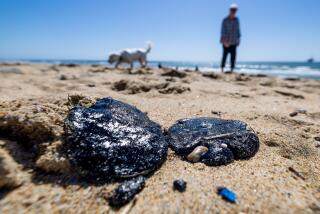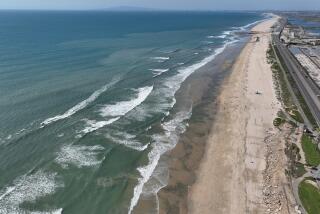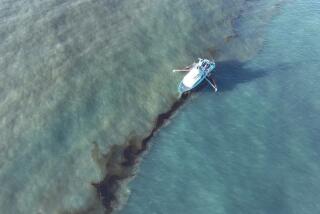Oil-damaged wetlands may just have to wait it out
- Share via
Reporting from Terrebonne Parish, Comfort Island — Although thick, sprawling oil slicks have vanished from much of the surface of the Gulf of Mexico, pockets of goo still menace delicate wetlands and there is no effective way to clean them up, experts said.
The best hope for the soiled bayous, some biologists said, may be to wait for Mother Nature to do its own cleaning. In the meantime, some patches of marsh will probably die.
On remote Comfort Island on the eastern edge of Louisiana, lush grass meets a soft-dirt beach and abandoned oyster shells. On the shore, shining like grotesque jewels, are droplets of oil. Push further into the mushy dirt, and spots of oil seep up.
“See? You can see it. Here, here and here,” said Paul Kemp, National Audubon Society vice president, pointing to a spot in the dirt. He picked up an oily seashell, rubbed the goo on his thumb, and sniffed it. “It comes in on every high tide.”
Countless insects and tiny crabs pop in and out of holes in the oil-stained dirt. They are key parts of a sensitive ecosystem — food that will be gobbled up later by sandpipers and shore plovers.
Oil is a poison to the wetlands. On Comfort Island, elsewhere in Breton Sound and farther south in Barataria and Terrebonne bays, the oil has appeared to kill grass along the water’s edge, leaving once-green reeds coarse, stunted and blackened.
Kemp said he hasn’t received an official estimate of the extent of wetlands oil exposure. But the damage is vast: Louisiana has 7,700 miles of shoreline, and much of it teems with wetlands and marshes, which were hit with the first waves of the oil.
The marshes are an important part of the Gulf of Mexico’s ecosystem. They are home to fish, shrimp and crab, and an important last stop for migratory birds who feed in the grassy waters before they make the long journey across the gulf. They also help calm storm-driven surges of water that pummel seaside communities.
If enough oil seeps into a marsh, “the plants die, and once the plant dies, there isn’t any natural regeneration,” said Denise J. Reed, a wetlands specialist and director of the Pontchartrain Institute for Environmental Sciences in New Orleans.
Once marshes turn into open sea, there’s no getting them back.
Just setting foot on the grasses can cause irreparable damage, pushing oil toward the plant roots deep below the mud. Breaking their stems will deprive the roots of oxygen. And pulling out oil-soaked grasses removes the only roots that keep the patches of soft marshland soil from eroding into the sea.
“They’re so sensitive that they succumb to the oil spill impacts, but you can’t go in and clean them up because you cause more damage,” said Wes Tunnell, associate director of the Harte Research Institute for the Gulf of Mexico Studies at Texas A&M University-Corpus Christi.
Some ideas for cleanup include burning grasses, vacuuming oil or flushing the marshes with fresh water.
However, “the removal process may be too aggressive and cause more damage to the marsh than would have occurred if a passive approach was utilized,” said a report by the Barataria-Terrebonne National Estuary Program and the National Oceanic and Atmospheric Administration.
Nonetheless, crews did attempt triage recently on an oil-contaminated marsh in Terrebonne Parish on the southern edge of Louisiana. With a fleet of 75 boats, crews treaded lightly, standing on boats to avoid crushing delicate grass. They tried to soak up oil with pads attached to poles — something like giant Q-tips — gingerly swabbing them through the marshes.
Success was limited. The grass still looked brown, and some seemed on the verge of death.
The best method may be to wait it out.
“We have nature on our side, we have a very warm climate, and we have fantastic amounts of natural microbes in our system” that can digest the oil, Reed said.
The long-term future of the wetlands, environmental groups said, also lies in efforts to stop the marshes from eroding into the sea. The marshes were already disappearing because of flood-control levees and canals built to help construct and maintain oil and gas pipelines.
The projects essentially starved the wetlands of their lifeblood: rich sediment from the Mississippi River. More than 2,300 square miles of Louisiana marshlands have disappeared since the 1930s.
Semuels reported from Terrebonne Parish, La., and Lin reported from Comfort Island, La.
More to Read
Sign up for Essential California
The most important California stories and recommendations in your inbox every morning.
You may occasionally receive promotional content from the Los Angeles Times.












